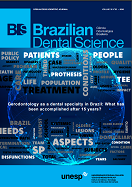Gerodontology as a dental specialty in Brazil: What has been accomplished after 15 years?
DOI:
https://doi.org/10.14295/bds.2016.v19i2.1254Resumo
Fifteen years ago, as a response to its rapidly aging population, Brazil was the first country to recognize gerodontology as a dental specialty. The aim of this paper is to evaluate the outcomes of this change by examining the increase in number of advanced gerodontology-trained dentists and identifying the volume of gerodontology-related research that has been published. The Brazilian Dental Board web site was searched in order to verify the number of specialists in gerodontology and their geographic distribution. In order to provide a quantitative assessment of the number of gerodontology-related graduate programs generated since the specialty was recognized, three sites were searched: a) the government database for post-graduate theses, which compiles all theses and dissertations completed as part of the requirements of accredited post-graduate courses in Brazil; b) the Brazilian Dental Library (Biblioteca Brasileira de Odontologia, BBO), which compiles papers published in Portuguese; and c) the PubMed database. Recognizing gerodontology as a dental specialty in Brazil required advanced training programs to be developed in geriatrics and gerodontology. The current number of specialists in gerodontology (276) is still lower than the needs of the Brazilian dental workforce.. Recognition of the specialty seems to have resulted in a significant increase in gerodontology-related research; however, this growth coincides with an overall increase in research in Brazil and is less extensive than for other specialties, which were recognized at the same time. More still needs to be done to add gerodontology to dental school curricula, even though a significant number of schools do teach the discipline.
Downloads
Downloads
Arquivos adicionais
Publicado
Como Citar
Edição
Seção
Licença
TRANSFERÊNCIA DE DIREITOS AUTORAIS E DECLARAÇÃO DE RESPONSABILIDADE
Toda a propriedade de direitos autorais do artigo "____________________________________________________________________" é transferido do autor(es) para a CIÊNCIA ODONTOLÓGICA BRASILEIRA, no caso do trabalho ser publicado. O artigo não foi publicado em outro lugar e não foi submetido simultaneamente para publicação em outra revista.
Vimos por meio deste, atestar que trabalho é original e não apresenta dados manipulados, fraude ou plágio. Fizemos contribuição científica significativa para o estudo e estamos cientes dos dados apresentados e de acordo com a versão final do artigo. Assumimos total responsabilidade pelos aspectos éticos do estudo.
Este texto deve ser impresso e assinado por todos os autores. A versão digitalizada deverá ser apresentada como arquivo suplementar durante o processo de submissão.




























